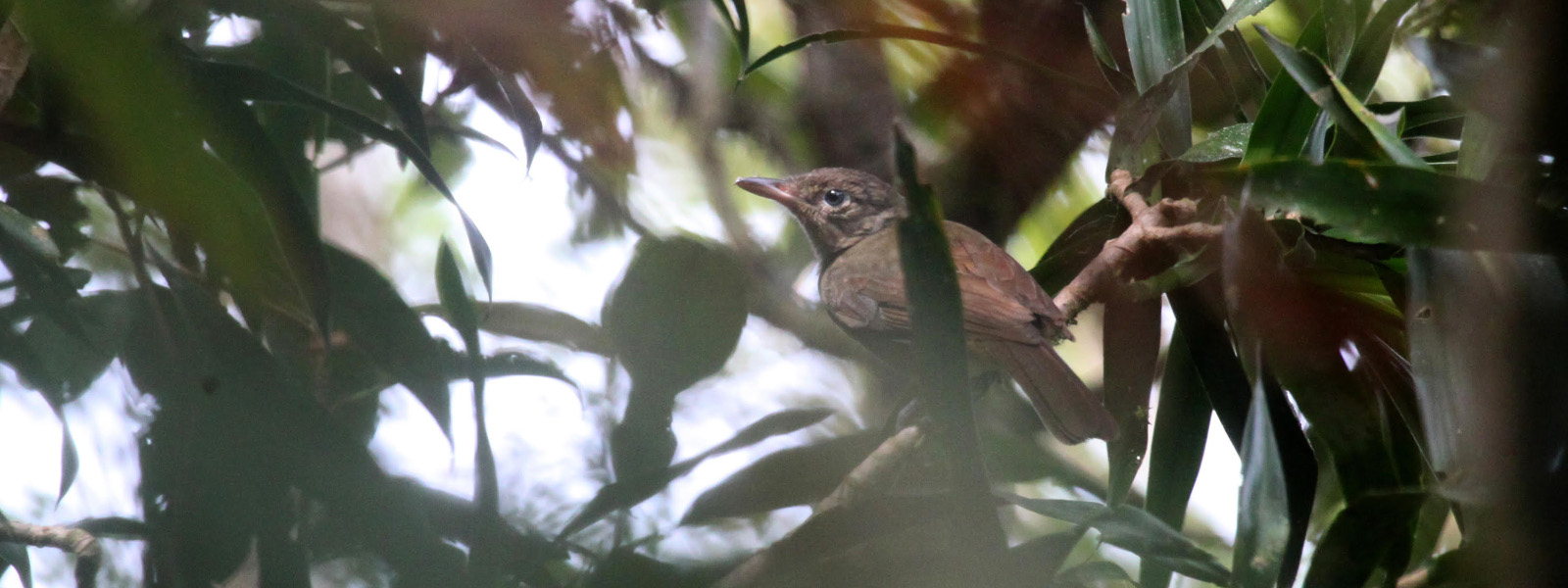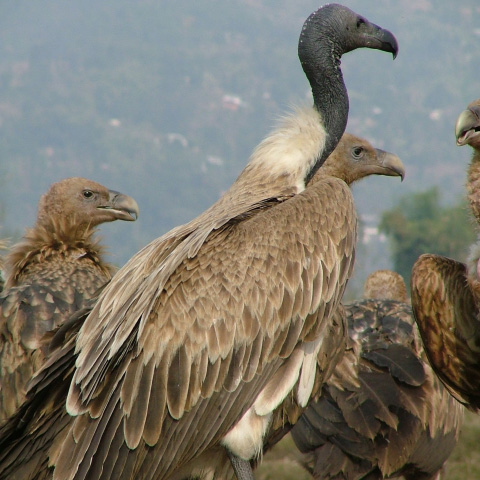Conservation Actions
Conservation Actions UnderwayThe Gunung Sahendaruman Protection Forest encloses an area of 3,500 hectares, but forest of good condition is only found within an area of 1,300 hectares (Martin 2018). Within this, only a proportion is suitable for the species (Martin 2018). The Protection Forest is largely mixed agriculture and spice tree plantations, which does not satisfy the designated role of the area to maintain environmental services (water, land stability). Some forest is additionally protected as watershed for a hydroelectric scheme in the Kentuhang valley, though this is within the Protection Forest boundary. Since 2014, the day-to-day management of the Protection Forest is under the jurisdiction of the provincial government, and a Forest Management Unit was established in 2017 to undertake this duty.
Burung Indonesia have been conducting periodic monitoring of the Critically Endangered species around the Sahendaruman crater with support from Vogelbescherming (Burung Indonesia 2009; Fauzan and Bashari 2016).
In 2015 habitat associations were investigated to model the current extent of suitable habitat and evaluate the potential for habitat restoration in different locations on the island (Martin 2018). Burung Indonesia developed a series of community-based Village Resource Management Agreements (VRMAs) at key villages around the crater during the Global Environment Fund-supported conservation project between 2002 and 2006, which successfully slowed rates of forest clearance (BirdLife Indonesia 2007). Between 1995 and 2005 the 'Action Sampiri'-project worked for biodiversity conservation in Sangihe and Talaud, conducting fieldwork, establishing conservation awareness programmes (including village and school meetings, distribution of leaflets etc.) and developing ideas for future land-use through agreements between interested parties (local people, local government, forestry officials and timber companies). Sangihe is a priority site for the Critical Ecosystem Partnership Fund, and Burung Indonesia are the Regional Implementation Team for the Wallacea Hotspot. A project conducting a forest cover survey through ground-truthing remote sensed forest cover maps began in 2017, and an extension of the VRMA programme is planned.
There have been proposals to change the designation of the Protection Forest on Gunung Sahengbalira to the more strictly controlled wildlife reserve; however, this is considered to have the potential to greatly deteriorate community attitudes to the site, with potentially severely damaging results (Fauzen and Bashari 2016). The Wildlife Conservation Society has also worked on the island since 2007, trying to promote sympathetic land use and development by villages surrounding Gunung Sahengbalira (N. Brickle in litt. 2010). A local resident and former bird guide is monitoring the loss of native forest for plantations of exotic tree species and trying to raise awareness of the threat this poses to Coracornis sanghirensis (Sykes 2009; W. Pangimangan in litt. 2015).
Conservation Actions Proposed
Ensure effective protection of habitat on Gunung Sahendaruman and work with local communities to restore recently degraded habitat within valleys otherwise suitable for the species. Support work to zone the remaining habitat within the Protection Forest boundary, and define a core forest area with collaboration with those that extract resources from the forest. Continue education programmes emphasising the value of forest cover to water retention and the benefits of sound farming practices on already cleared slopes. Lobby against government initiatives that encourage the clearance of native forest for plantations of exotic tree species. Conduct basic demographic research into the species to inform population breeding status, potential total population size and potential genetic issues that may compromise the species persistence.
Location Information
This species is endemic to the island of Sangihe, north of Sulawesi, Indonesia. Until its rediscovery in 1995, it was only known from one historical specimen collected in the late 19th century. It occurs around the Sahendaruman crater in the south of the island, and may have previously occurred on Gunung Awu (the type locality is given as a village on the slope of that volcano, but there are no further records). Sangihe Whistler occurs only within a highly restricted elevational band in primary forest along the ridgeline that form the crater rim. Habitat-association modelling indicated that the total area of suitable habitat for the species is only c.6 km2 (Martin 2018). Small-scale clearance and degradation for agriculture and hunting mammals are continuing within this range.Geographic Range
Extant
Indonesia
Population Information
The population size is likely to be extremely low (possibly fewer than 100 birds), given the tiny area of remaining habitat. An initial population estimate of 56-205 individuals (BirdLife Indonesia 2007) has not increased despite more recent surveys accessing a larger potential area. The most recent population estimate is between 92-255 individuals in total (Burung Indonesia 2009) and so is placed in the band 50-249 mature individuals. There is the potential for the population to be even lower than this, as these estimates are based on density estimates created from very few presence points (Burung Indonesia 2009).Threats
Original forest on Sangihe has been almost completely converted to agriculture. The largest habitat tract in which the species has been observed is only 225-340 ha in size and undergoing clearance by shifting cultivators in its lower reaches. For example, development of new plantations have continued around the Sahendarmang region (W. Pangimangen in litt. 2020). In 2009, it was reported that new government initiatives to plant alien tree species were resulting in the clearance of native forest (Sykes 2009). At first, planting was restricted to areas below 500 m; however, more recent reports indicate that planting is now taking place at higher elevations, in areas at 700-900 m (Sykes 2009). Having a montane distribution that is close to the maximum altitude within its range, this species is potentially susceptible to climate change (BirdLife International unpubl. data).IUCN Red List Account Link
Please click here to see the species' IUCN Red List Account page.Photo Credits
Hanom Bashari - Burung Indonesia (category and featured image)





